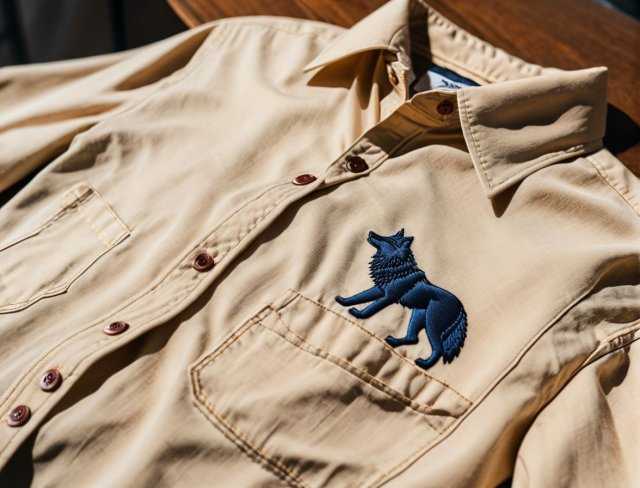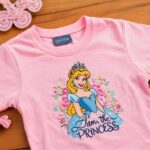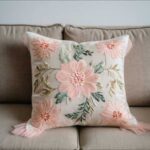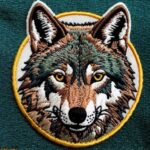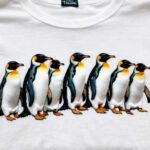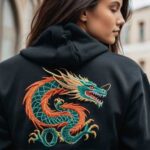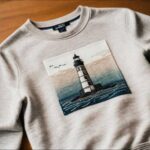Turn Old Clothes Into New Treasures
The Calculated Process of Upcycle Embroidery
Introduction
Upcycle embroidery merges creativity with sustainability, offering a transformative approach to revitalizing old garments through artistic stitching. This article explores the diverse techniques and creative applications of upcycle embroidery, from intricate motifs on plain fabrics to personalized accessories and thematic narratives. It embodies a commitment to repurposing fashion with a conscientious approach, reducing environmental impact while infusing each piece with a unique narrative and artistic flair.
Embroidery has long been celebrated for its ability to adorn fabrics with intricate patterns and personalized touches. Upcycle embroidery elevates this tradition by emphasizing the reuse and reinvention of textiles, promoting ethical fashion practices. By repurposing existing materials, embroiderers contribute to a more sustainable fashion ecosystem while exploring the artistry and craftsmanship inherent in every stitch.
Throughout this exploration, we delve into practical techniques for navigating challenges like selecting suitable stitches for different fabrics, achieving optimal thread tension, and ensuring durability through strategic reinforcement. Emphasizing sustainable practices in material sourcing and production, we underscore the role of upcycle embroidery in fostering conscious consumerism and a circular economy. Join us in uncovering how upcycle embroidery transforms fashion’s past into vibrant, meaningful pieces that embody creativity, sustainability, and individuality.
Understanding Upcycle Embroidery
Upcycle embroidery represents a sophisticated fusion of creativity and sustainable practices that revolutionizes the fashion industry. Unlike traditional embroidery methods, which often involve creating new garments or enhancing existing ones, upcycle embroidery takes a transformative approach by repurposing old textiles. This process not only reduces textile waste but also celebrates the inherent beauty and history of each piece of fabric.
At its essence, upcycle embroidery begins with the careful selection of garments poised for reinvention. Designers meticulously assess textiles based on their quality, texture, and unique characteristics that can be enhanced through embroidery. Fabrics ranging from vintage denim with its durable weave to delicate linens with their soft drape are chosen for their potential to carry intricate designs and withstand the embroidery process.
Once selected, these garments undergo meticulous preparation to ensure they are primed for transformation. Cleaning and stabilizing fabrics are crucial steps that pave the way for flawless embroidery execution. Each garment is treated with care, preserving its structural integrity while preparing it as a canvas for intricate stitching.
The creative process of upcycle embroidery unfolds as designers delve into digital tools and traditional techniques to craft bespoke designs. These designs not only complement the garment’s inherent style but also reflect contemporary aesthetics and personal narratives. Whether reimagining a faded shirt with vibrant floral motifs or infusing a classic coat with geometric patterns that evoke modern sensibilities, the possibilities for creative expression are boundless.
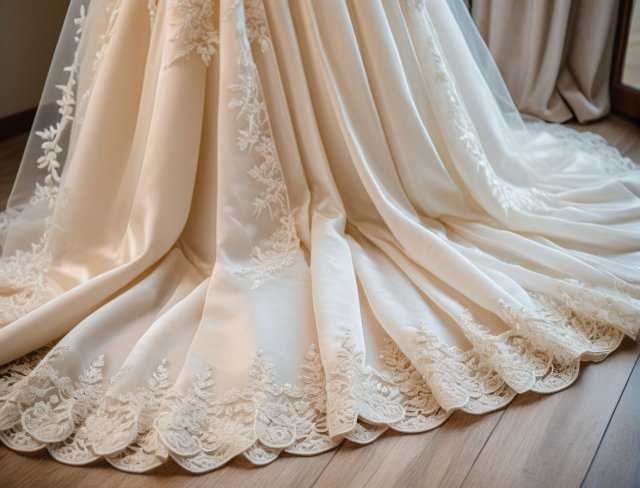
Technical proficiency plays a vital role in upcycle embroidery, where designers harness advanced embroidery machines capable of precision stitching. These machines automate intricate patterns and ensure consistent thread placement, achieving levels of detail and complexity that elevate the aesthetic and tactile qualities of the garments. The result is a harmonious blend of artistry and technology, where each stitch preserves the garment’s history while adding layers of narrative and visual interest.
Beyond its artistic merits, upcycle embroidery embodies sustainability at its core. By breathing new life into old garments, artisans contribute to reducing fashion’s environmental footprint and promoting mindful consumption. Each embroidered piece becomes a testament to responsible craftsmanship and thoughtful design, advocating for a fashion industry that values longevity, creativity, and ethical practices.
Upcycle embroidery transcends mere fashion trends by embracing the past to create a more sustainable future. It not only preserves the stories woven into each fabric but also invites wearers to connect with the artistry and intentionality behind their clothing. As consumers increasingly seek meaningful alternatives to fast fashion, upcycle embroidery emerges as a transformative practice that celebrates individuality, creativity, and environmental stewardship in every stitch.
The Creative Process Unveiled
Embarking on the journey of upcycle embroidery begins with a deliberate selection process. Choose garments that resonate with you, whether for their nostalgic value, unique textures, or potential for transformation. Look for fabrics that can withstand embroidery techniques, considering factors like fabric type and condition. Cleaning and preparing these garments ensure they are ready to become your canvas for creative expression.
Once your garments are selected and prepared, immerse yourself in the world of design. Utilize digital tools and traditional techniques to craft embroidery patterns that reflect your personal style and vision. Experiment with different motifs, such as floral designs, geometric shapes, or abstract patterns, to find what resonates most with you. Consider how these designs can enhance the garment’s existing features or tell a new story.
Technical execution is key to achieving professional results in upcycle embroidery. Leverage embroidery machines to automate intricate stitching with precision. Adjust settings like stitch density and thread tension to achieve the desired aesthetic and ensure durability. This technological assistance allows you to focus more on creativity and less on manual labor, streamlining the process while maintaining artistic integrity.
Throughout your creative journey, don’t hesitate to collaborate with skilled artisans or seek inspiration from fellow creators. Share ideas, techniques, and insights to enrich your designs and push creative boundaries. Embrace experimentation with different stitches, thread colors, and embellishments to discover new possibilities and refine your craft.
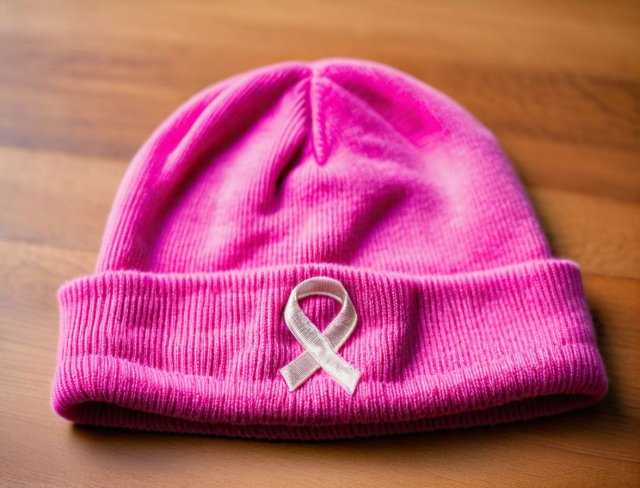
Remember that upcycle embroidery is not just about aesthetics; it’s a statement of sustainability and ethical consumption. By repurposing old garments, you contribute to reducing textile waste and promoting a more sustainable fashion industry. Each embroidered piece becomes a testament to mindful design and thoughtful craftsmanship, inviting others to appreciate the beauty and significance of handmade creations.
Embrace the creative process of upcycle embroidery as a journey of self expression and sustainability. Explore the transformative power of artistry and innovation, turning old garments into cherished treasures that tell your unique story. With each stitch, you contribute to a more conscious approach to fashion, where creativity and craftsmanship merge to inspire meaningful connections and a brighter future.
The Precision of Embroidery in Upcycling
In the realm of sustainable fashion, upcycle embroidery stands out as a transformative practice that breathes new life into older garments while minimizing environmental impact. At the heart of this practice lies the precision of embroidery, a critical element that enhances the aesthetic appeal, durability, and storytelling potential of upcycled clothing.
• Enhancing Aesthetic Appeal
Precision in embroidery allows designers to meticulously plan and execute intricate designs on old garments. Whether it’s covering stains or tears with elaborate patterns or enhancing plain fabrics with detailed motifs, embroidery adds a layer of sophistication and uniqueness to each piece. Automated embroidery machines excel in interpreting complex designs with consistent stitch placement and thread tension, ensuring that every detail contributes to the garment’s overall aesthetic appeal.
• Transforming Imperfections
One of the remarkable benefits of embroidery precision in upcycling is its ability to transform imperfections into design features. Garments that may have minor flaws or signs of wear can be revitalized through strategic embroidery placements. For instance, delicate floral motifs can elegantly cover patches of discoloration on a blouse, while geometric patterns can modernize faded denim jeans. This approach not only extends the lifespan of the garment but also adds a personalized touch that reflects the wearer’s style and values.
• Ensuring Durability and Longevity
The durability of upcycled clothing is significantly enhanced by the precision of embroidery. Machine embroidery secures threads firmly into the fabric, creating robust embellishments that withstand frequent wear and washing. This durability is crucial in sustainable fashion, where the goal is to reduce waste and encourage long term garment use. By reinforcing seams or embellishing high stress areas with strong, durable embroidery, designers ensure that upcycled pieces retain their integrity and aesthetic appeal over time.
• Promoting Artistry and Creativity
Precision embroidery opens doors for artistic expression and creative innovation in upcycling projects. Designers can experiment with diverse embroidery techniques, thread colors, and stitch patterns to achieve unique effects and textures. From intricate lace like designs on vintage blouses to bold, graphic motifs on upcycled jackets, the possibilities for creativity are limitless. This artistic freedom not only enriches the visual appeal of upcycled garments but also fosters a deeper connection between wearers and their clothing, imbuing each piece with personal significance and emotional value.
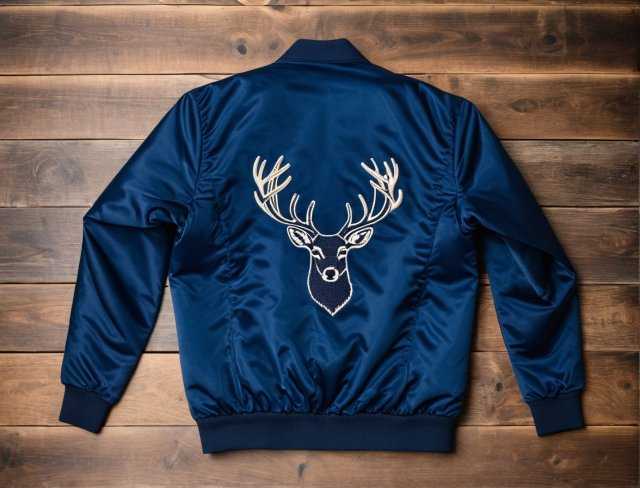
• Embracing Sustainable Practices
Beyond aesthetics and durability, the precision of embroidery supports sustainable fashion practices by repurposing existing materials. Upcycling reduces the demand for new textiles and minimizes environmental impact associated with production processes and textile waste. Each embroidered piece becomes a testament to conscious consumption and thoughtful design, encouraging consumers to appreciate the craftsmanship and effort invested in transforming fashion’s past into a sustainable and meaningful future.
The precision of embroidery plays a pivotal role in elevating upcycled clothing from mere garments to cherished works of wearable art. It combines technical proficiency with creative vision, allowing designers to reimagine and reinvent old textiles with precision and purpose. As fashion continues to evolve towards sustainability and individuality, upcycle embroidery emerges as a powerful tool for celebrating craftsmanship, promoting environmental stewardship, and inspiring a more mindful approach to personal style.
Creative Ideas for Upcycling
Upcycle embroidery offers endless creative possibilities to transform old garments and fabrics into personalized pieces of wearable art. Here’s an expanded exploration of each idea to inspire your next upcycling project!
1. Custom Patterns and Monograms
Personalization through embroidery adds a unique touch to garments, making them truly one of a kind. Monogramming, in particular, allows you to showcase initials, names, or meaningful symbols in an artistic way. Consider the placement of monograms, such as on shirt cuffs, jacket lapels, or even subtly on a pocket, to enhance the garment’s sophistication.Experiment with various embroidery techniques such as satin stitch, chain stitch, or cross stitch to achieve different textures and effects. Choose thread colors that complement the fabric and reflect the wearer’s personality, creating a piece that is both stylish and personal.
2. Revitalizing Plain Fabrics
Transforming plain fabrics with embroidery can turn simple garments into eye catching masterpieces. Explore a variety of design motifs to suit different styles and preferences. For instance, geometric patterns can add a modern touch to a plain blouse, while delicate floral designs can soften the look of a minimalist dress.
Consider the placement of embroidery, such as along necklines, sleeve cuffs, or waistbands, to highlight the garment’s silhouette and draw attention to its unique features. Experiment with thread weights and stitch densities to create depth and dimension, enhancing the fabric’s texture and visual appeal.
3. Embellishing Denim
Denim’s rugged texture provides an ideal canvas for creative embroidery. Elevate old denim jackets, jeans, or skirts by adding intricate designs that reflect your personal style. Floral motifs are a popular choice for denim embroidery, as they add a whimsical and feminine touch to the fabric.
Experiment with placement, such as along seams, pockets, or even across the entire back panel, to create a statement piece that stands out. Combine different embroidery stitches like running stitch, backstitch, and French knots to achieve varied textures and effects that enhance denim’s natural durability and appeal.
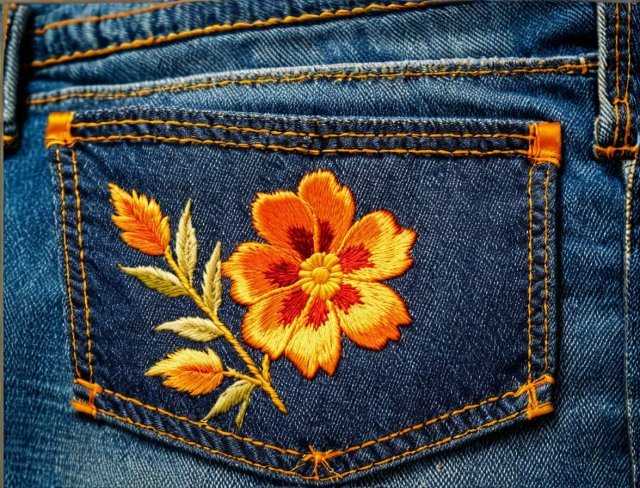
4. Patchwork Embroidery
Create dynamic patchwork designs by combining fabric patches with embroidery, offering a sustainable approach to fashion. Start by selecting fabrics in complementary colors and patterns, ensuring they work harmoniously together. Use embroidery to secure patches in place and embellish them with additional stitching, beads, or sequins for added visual interest.
Consider the overall layout of the patchwork, whether it’s a structured grid pattern or a free form collage, to create a cohesive design that tells a story. Patchwork embroidery not only breathes new life into old textiles but also allows for creative expression and individuality in each piece.
5. Upcycled Accessories
Extend your upcycle embroidery projects to include accessories that complement your wardrobe. Transform fabric remnants into stylish items like embroidered tote bags, clutch purses, or cosmetic pouches. For example, embroider intricate floral patterns on a tote bag for a chic and functional accessory that adds a touch of handmade charm to everyday outings.
Personalize hats with embroidered designs, such as logos, patterns, or quotes, to reflect personal interests and elevate casual attire. Consider embroidery techniques like appliqué or embellishment with beads and sequins to add texture and sparkle to accessories, making them unique and statement worthy.
6. Decorative Embellishments
Use embroidery to add decorative accents that enhance the overall aesthetic of garments. Delicate lace like motifs along neckline or cuffs can impart a romantic and vintage inspired look to dresses and blouses. Bold, graphic designs on sleeves or collars using embroidery create a modern and artistic statement that elevates basic pieces.
Incorporate beads, sequins, or metallic threads into your embroidery stitches to add shimmer and texture, enhancing the garment’s visual appeal. Experiment with contrasting thread colors and stitch techniques to achieve intricate patterns and detailing that showcase your craftsmanship and attention to detail.
7. Narrative Embroidery
Tell a story through embroidery by incorporating meaningful themes or imagery into your designs. Create embroidered scenes that evoke memories, celebrate cultural heritage, or convey personal beliefs. For instance, embroider a landscape that holds sentimental value, a favorite vacation spot or childhood home, or stitch symbols that represent passions and aspirations.
Narrative embroidery adds depth and emotional resonance to garments, transforming them into wearable art pieces that resonate with personal narratives and values. Consider the placement and scale of embroidery to ensure it enhances the garment’s overall design and creates a cohesive visual narrative.
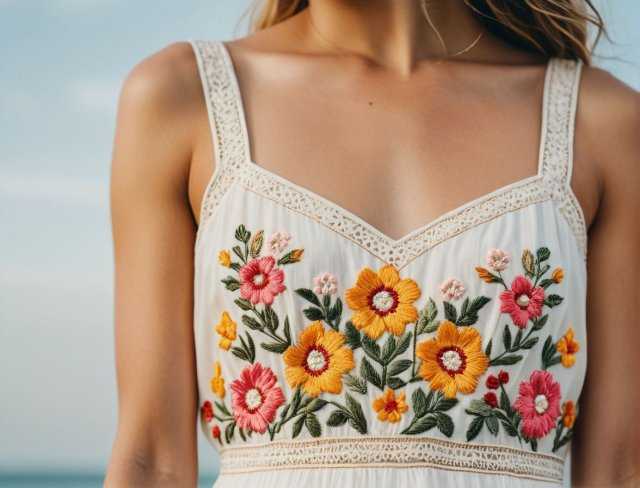
8. Embroidered Accents and Trims
Enhance garments with subtle yet impactful embroidered accents and trims that add sophistication and detail. Embroider delicate borders along sleeves, collars, or hemlines using intricate stitching patterns, such as scallops or arabesques. Add small motifs or geometric patterns to pockets, seams, or button plackets to create focal points that elevate the garment’s design.
Choose thread colors that complement the fabric and enhance its texture, creating a cohesive and polished look. Embroidered accents and trims allow you to customize garments with precision and finesse, adding a touch of craftsmanship and elegance to your wardrobe.
9. Seasonal and Holiday Themes
Celebrate seasonal festivities or holidays with themed embroidery designs that capture the spirit of each occasion. For winter holidays, embroider snowflakes, reindeer, or festive ornaments in traditional reds and greens. Spring and summer themes can include floral motifs in vibrant colors to signify renewal and growth.
Consider fall inspired designs like pumpkins, leaves, or harvest scenes in warm earth tones. Incorporate seasonal colors, motifs, and symbols into your embroidery to create garments that reflect the essence of each season. Seasonal embroidery allows you to infuse garments with a sense of occasion, making them perfect for festive gatherings or everyday wear during specific times of the year.
10. Embroidered Patches and Appliqués
Explore the versatility of embroidered patches and appliqués to add playful elements to garments and accessories. Create whimsical patches depicting animals, plants, or abstract shapes that can be sewn onto jackets, backpacks, or jeans. Appliqué larger embroidered pieces, such as flowers, logos, or initials, onto garments for bold statements that reflect personal style.
Use embroidery stitches to secure patches or appliqués in place with decorative stitching patterns like blanket stitch or chain stitch. This technique not only adds personality and customization to your wardrobe but also allows for easy updates and alterations to your favorite pieces.
Each of these creative ideas invites you to explore the versatility and expressive potential of upcycle embroidery. Whether you’re an experienced embroiderer or new to the craft, these projects offer opportunities to experiment, innovate, and personalize fashion while contributing to a sustainable lifestyle. Embrace the artistry of upcycle embroidery to transform fashion’s past into vibrant, meaningful pieces that resonate with beauty, purpose, and individuality.
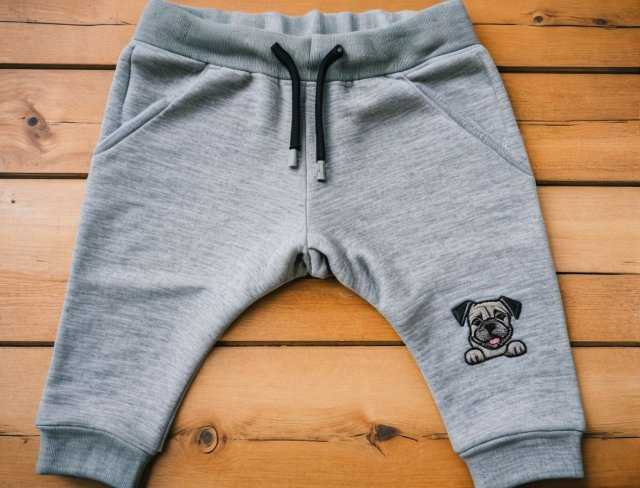
Challenges and Solutions
Embarking on upcycle embroidery projects introduces embroiderers to a range of challenges that require both creativity and problem solving skills to overcome effectively. One significant hurdle is selecting the appropriate embroidery techniques and designs that harmonize with the fabric’s texture and structure.
Different fabrics, whether it’s denim, delicate silk, or stretchy knits, demand tailored approaches. For instance, dense stitches like satin stitch may overwhelm lightweight fabrics, while delicate fabrics may require finer needles and adjusted tension settings to prevent pulls or puckering. Solutions lie in experimenting with stitch types and adjusting thread weights to achieve optimal results that enhance rather than detract from the fabric’s natural drape and integrity.
Managing thread tension poses another common challenge in upcycle embroidery, particularly when working with varied fabrics and thicknesses. Improper tension can lead to uneven stitching, thread breakage, or fabric distortion. Solutions involve mastering the adjustment of tension settings on your embroidery machine or hand embroidery techniques. Understanding how different threads behave and practicing on scraps of similar fabric can help fine tune tension settings for smoother, more consistent stitching.
Ensuring durability and longevity in upcycled embroidered pieces is crucial, especially when revitalizing older garments. Integrating new embroidery without compromising the garment’s structural integrity requires strategic placement and reinforcement. Using appropriate stabilizers and backing materials helps maintain fabric stability during embroidery, reducing the risk of distortion or puckering. Reinforcing high stress areas with additional stitching or appliqué techniques enhances the garment’s strength and longevity, ensuring that your embroidered creations withstand regular wear and washing.
Sourcing sustainable and ethical materials presents another challenge for conscientious embroiderers. Choosing eco-friendly threads made from organic cotton or recycled polyester, as well as repurposing vintage fabrics and thrifted garments, supports sustainable practices but requires careful sourcing and planning. Solutions include researching suppliers committed to ethical production practices and exploring innovative materials that minimize environmental impact without compromising on quality or performance.
Despite these challenges, upcycle embroidery offers rewarding solutions. Each challenge presents an opportunity for creative problem solving and skill development. Experimenting with new techniques and materials fosters innovation and personalization in embroidery projects. Embracing sustainable practices not only reduces environmental footprint but also aligns with ethical fashion values, promoting conscious consumerism and contributing to a more circular economy.
Navigating these challenges with patience, perseverance, and a commitment to craftsmanship enhances the quality and uniqueness of upcycled embroidered pieces. By overcoming technical hurdles and embracing sustainable principles, embroiderers can create artful, durable garments that resonate with both beauty and purpose.
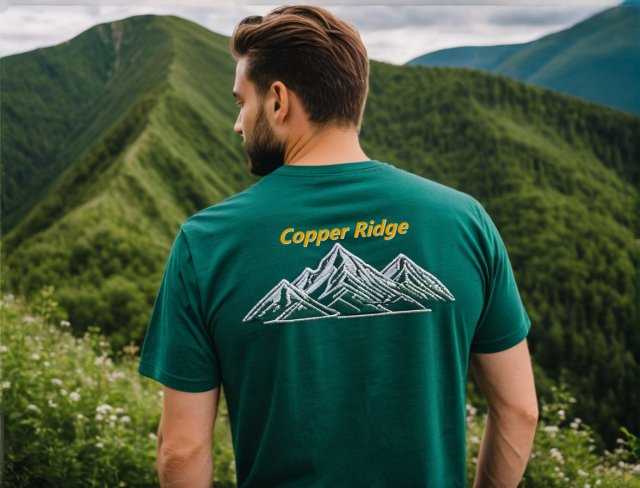
Conclusion
Upcycle embroidery is a transformative art form that revitalizes old garments into personalized masterpieces, blending creativity with sustainability. Throughout this article, we’ve explored its diverse techniques, from intricate designs on plain fabrics to thematic narratives and personalized accessories. Each stitch tells a story, whether through monograms, patchwork, or seasonal themes, celebrating creativity and conscientious consumption.
Navigating the challenges of upcycle embroidery, choosing suitable techniques for different fabrics, managing thread tension, and ensuring durability through strategic reinforcement, strengthens both skill and ingenuity. Embracing sustainable practices in material sourcing and production enhances environmental impact while promoting ethical fashion choices.
As you embark on your upcycle embroidery journey, each piece created carries a unique narrative, reflecting personal style and values. Whether you’re new to embroidery or seasoned in the craft, let each stitch embody creativity, craftsmanship, and the beauty of sustainable fashion. Let upcycle embroidery inspire you to transform old garments into cherished treasures that resonate with creativity, sustainability, and individuality.
Now that you have read through this article, feel free to SHOP for products we have created. If you are looking for something special which isn’t in our store, feel free to contact us.

